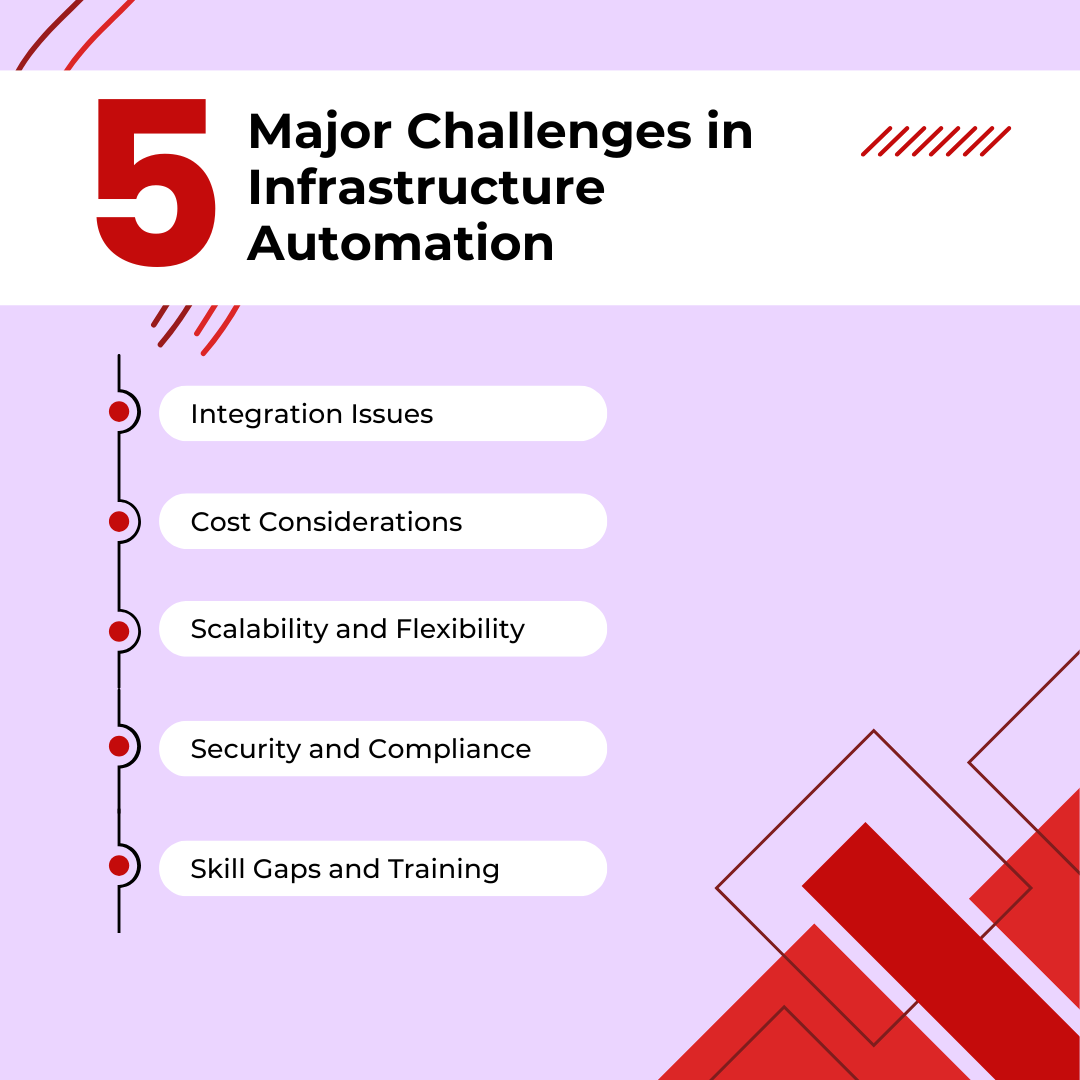Introduction
Infrastructure automation offers remarkable benefits, yet it brings significant challenges. Organizations frequently face difficulties integrating new automation tools with existing legacy systems, managing unforeseen costs, and ensuring solutions scale effectively. These hurdles can disrupt operations and lead to inefficiencies.
However, by identifying these obstacles and implementing strategic approaches, businesses can overcome these issues and fully leverage automation to drive operational excellence and improve overall performance.
Understanding Infrastructure Automation
Infrastructure automation is the use of technology to manage and control IT infrastructure through automated processes rather than manual intervention. This approach encompasses a range of tools and practices designed to streamline operations, enhance efficiency, and ensure consistency across IT environments.
Definition and Scope
At its core, infrastructure automation involves automating repetitive and complex tasks associated with IT infrastructure management. This includes provisioning, configuration, monitoring, and maintenance of hardware and software resources.
Key components of automation typically include orchestration tools, configuration management systems, and provisioning tools. These elements work together to reduce manual workload and minimize human error.
Importance in Modern IT
In today’s rapidly evolving IT environment, automation is crucial for a variety of reasons. First, it boosts efficiency by accelerating repetitive tasks and reducing the time required for deployment and management.
This results in faster delivery of services and applications, which is crucial for maintaining a competitive edge. Second, automation ensures consistency across systems, eliminating variability that can arise from manual processes. This consistency improves reliability and minimizes the chances of errors.
Furthermore, automation plays a critical role in scalability. As organizations grow, manual management becomes impractical. Automated systems can scale resources up or down according to demand, ensuring optimal performance and cost-effectiveness.
Additionally, automation supports better monitoring and management of IT environments, allowing for proactive issue resolution and improved overall system health.
Major Challenges in Infrastructure Automation
While infrastructure automation offers numerous advantages, it also presents several significant challenges that organizations must navigate to achieve successful implementation.
Integration Issues
One of the foremost challenges is integrating automation tools with existing legacy systems. Many organizations rely on older systems that may not be compatible with new automation technologies, leading to integration difficulties.
Additionally, ensuring interoperability between different automation tools can be complex. When disparate tools fail to work seamlessly together, it can result in inefficiencies and potential disruptions.
Cost Considerations
The financial aspect of automation presents another hurdle. The upfront cost of automation tools and technologies can be significant. Beyond the upfront costs, organizations may face hidden expenses, such as ongoing maintenance, updates, and potential scalability costs. These financial implications can strain budgets, particularly for smaller enterprises or those with tight financial constraints.
Scalability and Flexibility
Scalability is another critical concern. As businesses expand, their automation solutions need to scale to meet increasing demands. However, many automation systems struggle to adapt to increasing demands or changing requirements. This inflexibility can hinder an organization’s ability to respond to growth or evolving business needs effectively.
Security and Compliance
Automating sensitive processes introduces security risks, such as vulnerabilities that can be exploited if not properly managed. Ensuring that automated systems comply with industry regulations and standards adds another layer of complexity. Neglecting security and compliance issues can lead to data breaches and legal consequences.
Skill Gaps and Training
Lastly, the implementation of automation requires specialized skills. Finding personnel with the necessary technical expertise can be challenging. Additionally, ongoing training is essential to keep staff updated on evolving technologies and best practices, which adds another dimension to managing automation effectively.

Real-Life Examples and Case Studies
Understanding infrastructure automation's challenges is more insightful when illustrated with real-life examples and case studies. These examples highlight how organizations have navigated automation hurdles and the lessons learned from their experiences.
Successful Implementations
A prominent example is the multinational tech company, IBM. IBM implemented infrastructure automation to streamline its data center operations, achieving significant efficiency gains. By automating routine tasks such as server provisioning and configuration, IBM reduced deployment times from weeks to hours. This transformation not only improved operational efficiency but also enhanced scalability, allowing IBM to manage increasing workloads with ease.
Similarly, Netflix, a leading streaming service, leveraged automation to handle its massive and dynamic infrastructure. The company uses a combination of tools like AWS CloudFormation and custom automation scripts to manage its vast array of servers and services. This approach has enabled Netflix to deploy new features quickly and maintain high service availability, despite fluctuating demand.
Lessons Learned
However, not all automation initiatives are seamless. A financial services firm faced significant challenges when integrating automation tools with its legacy systems. The initial deployment led to several compatibility issues, causing disruptions in daily operations. The company learned the importance of thorough planning and incremental implementation, emphasizing the need for comprehensive testing before full-scale rollout.
Another lesson comes from a healthcare provider that struggled with automation’s security implications. The provider faced a data breach due to insufficient security measures in its automated processes. This incident underscored the critical need for robust security protocols and regular compliance audits to protect sensitive information.
Strategies for Overcoming Automation Challenges
Tackling the challenges of infrastructure automation demands a well-planned strategy. By implementing best practices and proactive measures, organizations can effectively navigate obstacles and maximize the benefits of automation.
Adopting Best Practices
A successful approach is to implement the strategy in phases. Rather than deploying automation tools across the entire organization at once, start with a pilot project to test the new system in a controlled environment. This enables modifications and improvements before full deployment, minimizing the risk of large-scale problems.
Additionally, choosing the right automation tools and vendors is crucial. Evaluate tools based on compatibility with existing systems, scalability, and support services to ensure they meet the organization’s specific needs.
Training and Development
Investing in skill development is essential for overcoming the technical challenges of automation. Implement training programs that focus on both the technical aspects of automation tools and broader IT management skills.
Encouraging continuous learning and knowledge sharing within teams helps keep staff updated on the latest advancements and best practices. This proactive approach helps bridge the skill gap and ensures that personnel are well-equipped to manage and optimize automation systems.
Cost Management
To manage costs effectively, develop a comprehensive budget plan that accounts for both initial and ongoing expenses. Regularly review and adjust the budget as needed to accommodate unforeseen costs.
Additionally, measure the return on investment (ROI) of automation projects to ensure they deliver the expected value. Evaluating ROI helps validate expenses and inform future investments in automation technology.
Enhancing Security and Compliance
To uphold robust security and compliance, it's essential to implement rigorous security protocols and conduct frequent audits. Establish a comprehensive security framework that addresses potential vulnerabilities in automated systems.
Regular compliance checks are also necessary to verify adherence to industry regulations and standards. By prioritizing security and compliance, organizations can protect sensitive data and avoid legal issues.
Future Trends in Infrastructure Automation
As technology evolves, so does the landscape of infrastructure automation. Staying ahead of emerging trends can help organizations harness the full potential of automation while adapting to new challenges.
Emerging Technologies
One of the key trends is the rise of Artificial Intelligence (AI) and Machine Learning (ML) in automation. AI-powered automation tools are growing more advanced, enhancing decision-making and offering predictive capabilities.
For example, AI can optimize resource allocation by analyzing patterns and forecasting demand, enhancing operational efficiency and responsiveness.
A key advancement is the rise of Infrastructure as Code (IaC), which enables IT teams to manage and provision infrastructure through code. This approach simplifies resource deployment and management, ensuring consistency and repeatability. Additionally, it enhances version control and fosters better collaboration among teams.
Evolving Best Practices
As automation technology advances, best practices are also evolving. There is a growing emphasis on DevOps practices, which integrate development and operations teams to streamline workflows and enhance collaboration. This cultural shift supports continuous integration and continuous delivery (CI/CD), facilitating faster and more reliable automation deployments.
Moreover, there is an increasing emphasis on security and compliance. Future automation tools are expected to include advanced security features, such as automated threat detection and response mechanisms, to address growing cybersecurity concerns. Compliance frameworks are also evolving to better align with emerging technologies and regulatory requirements.
Key Takeaways
- Integration Challenges: Effective infrastructure automation requires seamless integration with existing legacy systems and ensuring interoperability between different tools.
- Cost Management: Initial investments and hidden costs can be significant; careful budgeting and ROI analysis are crucial.
- Scalability and Flexibility: Automation solutions must be scalable and adaptable to accommodate organizational growth and changing needs.
- Security and Compliance: Robust security protocols and regular compliance audits are essential to protect sensitive data and meet regulatory requirements.
- Emerging Trends: AI, Machine Learning, and Infrastructure as Code are shaping the future of automation, enhancing efficiency and intelligence in IT operations.
Conclusion
Infrastructure automation enhances efficiency and scalability but comes with challenges such as integration issues, costs, and security concerns. Addressing these challenges through phased implementation, careful cost management, and robust security measures is essential.
Staying informed about emerging trends like AI and Infrastructure as Code will further optimize automation strategies. By proactively tackling these issues, organizations can fully leverage automation's benefits for improved operational performance.

